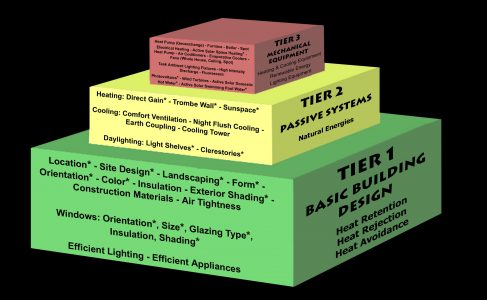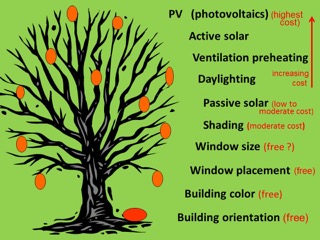Post contributed by Kenzley Defler, Office of Sustainability Intern
In the culture of today’s world, most people enter numerous buildings every day. We spend about 90% of our time inside buildings. We leave our houses and go to school or work. We shop at grocery stores, workout in gyms, and watch movies in huge theaters. Most of the structures in which we carry out our daily lives, however, aren’t given much thought. Many people either don’t understand or don’t consider the vast energy use of buildings, making them a leading factor in climate change. This is not the case for architect and Professor Emeritus, Norbert Lechner.
Norbert obtained an undergraduate degree in architecture from City College in New York City before attending graduate school at Columbia University, earning a Master of Science in Architecture and Architectural Design. When asked about his educational experiences, Norbert expresses that ideas related to building energy and sustainability were never mentioned, meaning there were many generations of architects trained without the awareness of how much influence they have in the future of our planet. In the United States, buildings account for half of all energy consumption. According to Norbert, this means buildings are responsible for a significant portion of climate change and its effects. For many years, the issue of climate change wasn’t known in the architecture field, posing a sustainability challenge. Norbert stresses that great solutions are available. However, a lack of education inhibits them from being implemented. Teaching architects about energy-efficient design techniques and educating homeowners to choose more sustainable options are vital to overcoming the impact buildings have on climate change.
Norbert has set out to solve this educational deficit through his career work. For 33 years, Norbert taught various courses at Auburn University, including those related to environmental control in architecture and the history of buildings. In his interaction with both architecture and building science students, Norbert emphasized the importance of design elements to make the heating, cooling, and lighting systems of buildings more sustainable.

Designers should work from Tier 1 up to reduce energy demand prior to maximizing efficiency.
Norbert also helped found BEEnow, or Built Environment Education now, a program to certify schools that include low energy design in their architecture curriculum. By creating positive pressure for schools to change their priorities through a credit system, BEEnow wants to ensure architecture students graduate with the skills needed to create buildings with low energy and water requirements. The idea, currently still in developmental stages, is expected to become a reality in the near future. Norbert’s involvement on the founding committee of BEEnow demonstrates his dedication to improving architectural education by ensuring that the importance of sustainability, specifically energy use, is addressed in colleges around the country.
You may be wondering what this education entails. The answer lies in Norbert’s image of the 3-tier approach to sustainable design. Tier 1 is the basic building design elements, decisions made in planning of every project, while Tier 2 focuses on passive design strategies. Within a building, heating, cooling, and lighting account for the majority of total energy consumption and 85% of that demand can be eliminated by focusing on changes to Tiers 1 and 2. If basic design of a building were changed, the mechanical equipment needed for heating, cooling, and lighting (represented by Tier 3) would only be 15% of that typically needed. Improvement of Tier 3 strategies such as utilization of renewable energy sources or more efficient lighting fixtures would then be more than enough to cover the building’s energy needs.
When asked the best way to make buildings more sustainable, many people jump directly to Tier 3 and suggest using solar panels or other renewable sources of power. Norbert explains how this is unrealistic because unfortunately, the current technology of renewables isn’t developed enough to support an enormous energy demand. However, he also emphasizes that after addressing basic building design elements, the remaining energy needs are reduced enough to easily be supplied by renewable installations. Therefore, the primary focus of sustainable building should be on reducing the amount of energy needed, and then the use of efficient sources.

Building designers and owners have a number of options to pick “low-hanging fruit” related to energy.
Norbert realizes economic factors are very important and provides the analogy of a tree with low hanging fruit to explain how very little extra money can make a huge difference in sustainability. As shown in the image, many free design elements can still greatly reduce a building’s energy. This energy reduction can come from a variety of connected strategies, notably solar-responsive design, the topic of Norbert’s book titled, “Heating, Cooling, Lighting: Sustainable Design Methods for Architecture.” Solar responsive design focuses on orientation of a building to utilize natural elements for maximized efficiency of a building. As Norbert explained, building orientation is the single most important factor in allowing effective design. Specifically, ideal buildings in the winter will obtain heat naturally from the sun and reject this heat in the summer while still harvesting daylight to allow electric lights to be turned off. Building orientation, along with factors such as roof color and window placement should be considered first when aiming for improved efficiency. Norbert suggests, “picking the low hanging fruit first to make a huge change at lower economic cost.” He stresses that investing large amounts of money isn’t always feasible or most effective, and therefore, we must use free and inexpensive strategies first, especially when these changes are actually more effective in reducing a building’s energy needs.
In recent years, LEED, or Leadership in Energy and Environmental Design, has brought attention to both the economic and resource efficiency discussions of buildings. The US Green Building Council’s program certifies buildings meeting certain requirements across several areas of sustainability. LEED-certified buildings save money, use less resources, and reduce greenhouse gas emissions while earning points to receive a rating of Certified, Silver, Gold, or Platinum. As Norbert explains, new versions and updates of the system ensure validity of awarded points, and therefore, success of the program. In his experience, LEED’s impact extends further than simply saving energy in that its implementation changed the mindset of the United States by giving words such as “sustainability” and “green” a positive association.
There are currently four LEED buildings on Auburn’s campus: the Gorrie Center, Aquatic Resource Management Center, Auburn Research Park Building One, and Office of Information and Technology building. According to Norbert, the Gorrie Center is one of the most energy efficient buildings on campus and a great example of how orientation significantly impacts consumption, as this building was designed with the intention of “picking the low hanging fruit.”
The ultimate goal of energy efficiency is a net-zero building, in which the amount of energy needed to run the building is provided completely on site. Norbert acknowledges that net-zero office buildings are more complicated to design, because buildings are typically high consuming entities. However, the National Renewable Energy Laboratory office building in Colorado, which serves as a research support facility for their solar fields, proves that although difficult, net-zero design for office buildings is possible. Residential buildings, which don’t require as much energy as commercial buildings, also have been able to achieve this goal as evidenced by the Beddington Zero Energy Development, a series of apartment homes in London. Going another step further, the Heliotrope house in Germany combines several design and technological initiatives to achieve energy positive status, meaning this structure generates more energy over a year than what it consumes.
Clearly, many buildings already accomplish sustainable advancements, but there’s still more progress to be made. Norbert’s work to infuse sustainability in architectural education advances this goal. In his words, “The design of a building is where the solution really lies. If we want to change that, we need to change architectural education.” He truly understands the power an architect holds in implementing positive change toward more efficient buildings and encourages others to become more aware of this influence. His passion for building sustainably serves as an example of the impact individuals can have when they remain dedicated to topics of interest.





Norbert Lechner is a true champion of Sustainability and one of th most influential educators I have known. As a former colleague in Building Science at AU, I observed him sowing the seeds of sustainability for three decades to his colleagues and many students. His book has become an authoritative classic on energy use in buildings, and gained him international recognition. He has been invited by architecture schools all over the world to present his common sense and practical ideas for sustainable buildings. Auburn University was lucky to have him, and continues to benefit from his name long after his retirement.
Michael Hein
Professor Emeritus
McWhorter School of Building Science
Auburn University